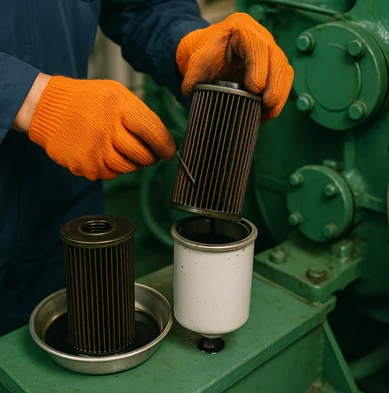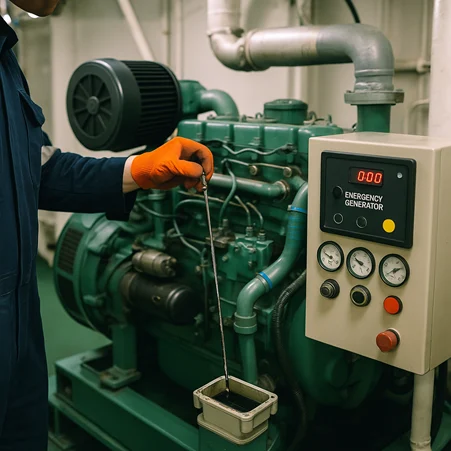Why the Emergency Generator Matters?
Imagine you’re out at sea. It’s night. The main power fails. Radar dies, lights go out, the steering is lost, everything suddenly comes to a standstill.
Now ask yourself – what’s the one thing standing between your ship and disaster?
That’s right: the Emergency Generator.
This small but powerful backup system is what keeps essential functions alive when the main power goes down. It brings power to your navigation lights, GMDSS, emergency fire pump, steering system, and even engine control systems, long enough for you to recover or escape danger.
So if it fails… well, that’s the kind of thing seafarers remember for life.
That’s why regular maintenance of the emergency generator is not optional, it’s your duty.
Let’s break it down simply.
Emergency Generator Maintenance Tasks You Must Know
Whether you’re a cadet doing engine rounds or a junior engineer taking your first handover, these are the jobs you’ll need to check, do, or monitor regularly.
1. Engine Sump Oil – Check and Change
- What to do: Check the oil level using the dipstick.
- When to change: Every 250 – 500 hours of running (as per maker’s manual).
- Watch for: Black, sticky oil with soot or fuel smell, means it’s time for a change.
- Pro tip: If the generator uses high-sulfur fuel (0.5% or more), change oil more frequently.
2. Clean the Air Filter
- The engine breathes through this filter. If it’s clogged, the engine suffocates.
- Types:
o Oil bath type (clean and refill oil)
o Dry cartridge (replace after 5–7 cleanings or 1 year)
Signs of trouble: Loss of power, black smoke, increased fuel consumption.
3. Drain the Water Separator
- Some fuel lines include a water separator to remove water from fuel.
- Check daily or as part of watch rounds.
- Why important: Water in fuel causes poor combustion, corrosion, and engine damage.
4. Battery Electrolyte Level
- The battery is often the only starting source for the emergency generator
- Check: Open cell caps, use a level stick or level-indicator cap.
- Top up with distilled water only never tap water.
5. V-Belt Tension and Condition
- V-belts drive essential parts like the alternator or coolant pump.
- Check tension by pressing midway between pulleys. Deflection should be ~10–15 mm.
· Replace if: You see cracks, fraying, or if it slips.

6. Clean or Renew Oil Filters
- Types may include:
o Lube oil filter
o Fuel feed pump filter
o Bypass filter or centrifuge filter - Clean or replace as per running hours and oil condition.
7. Check Valve Clearance (Tappet Clearance)
- This ensures the valves open and close correctly.
- Always check when the engine is cold.
- Follow the clearance values in the engine manual.
- Improper clearance = hard starting, low power, noise.
8. Test Alarms and Trips
- Every safety shutdown and alarm must function without fail.
- Test them regularly usually monthly or during routine maintenance.
- If an alarm doesn’t work, treat it as a critical fault and repair immediately.
Real-World Advice from the Engine Room
- Don’t skip tests. The emergency generator isn’t used daily, so faults stay hidden until it’s too late.
- Always keep a log. Note down each check and maintenance done. Helps during PSC, audits, and breakdowns.
- Practice auto-start tests. Know how to simulate a power failure to see if the generator starts automatically.
- Store spares. Keep extra filters, belts, and oil in the emergency locker or engine store.
The emergency generator is your ship’s lifeline in a crisis. If it fails when you need it most, there’s no second chance. As a cadet or junior engineer, your attention to small things—like oil level or a cracked belt can prevent major failures.
Start with the basics. Build the habit. And always remember: emergency equipment must be treated like it will be needed tonight because one day, it will be.
Over to You!
Have you tested your emergency generator during drills? Ever found a hidden fault? Share your story with us at Nav Insider and help train the next generation of seafarers.


